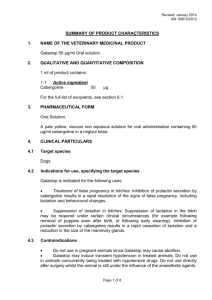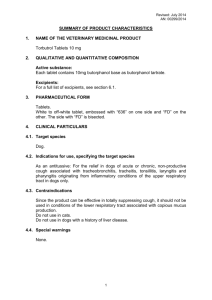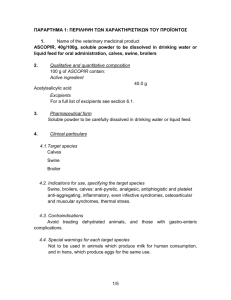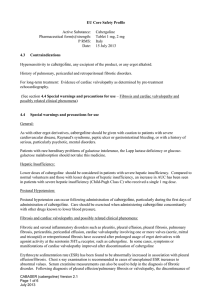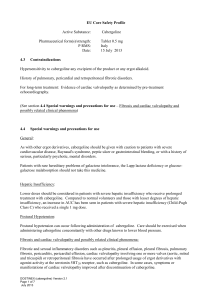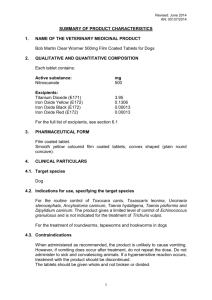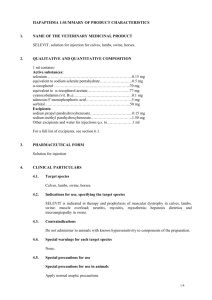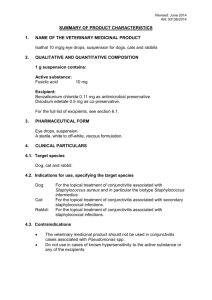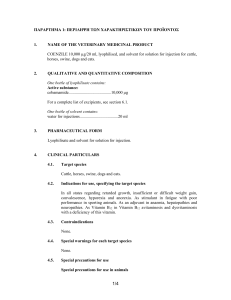4. clinical particulars - Veterinary Medicines Directorate
advertisement
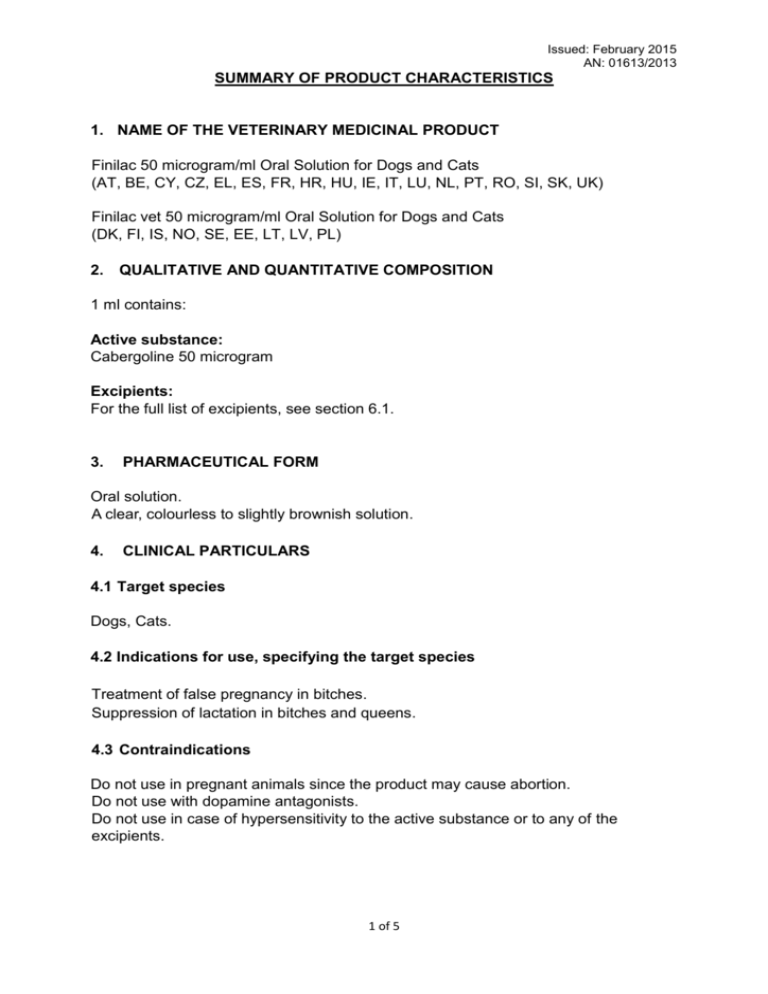
Issued: February 2015 AN: 01613/2013 SUMMARY OF PRODUCT CHARACTERISTICS 1. NAME OF THE VETERINARY MEDICINAL PRODUCT Finilac 50 microgram/ml Oral Solution for Dogs and Cats (AT, BE, CY, CZ, EL, ES, FR, HR, HU, IE, IT, LU, NL, PT, RO, SI, SK, UK) Finilac vet 50 microgram/ml Oral Solution for Dogs and Cats (DK, FI, IS, NO, SE, EE, LT, LV, PL) 2. QUALITATIVE AND QUANTITATIVE COMPOSITION 1 ml contains: Active substance: Cabergoline 50 microgram Excipients: For the full list of excipients, see section 6.1. 3. PHARMACEUTICAL FORM Oral solution. A clear, colourless to slightly brownish solution. 4. CLINICAL PARTICULARS 4.1 Target species Dogs, Cats. 4.2 Indications for use, specifying the target species Treatment of false pregnancy in bitches. Suppression of lactation in bitches and queens. 4.3 Contraindications Do not use in pregnant animals since the product may cause abortion. Do not use with dopamine antagonists. Do not use in case of hypersensitivity to the active substance or to any of the excipients. 1 of 5 Issued: February 2015 AN: 01613/2013 4.4 Special warnings for each target species Additional supportive treatments should involve restriction of water and carbohydrate intake and increased exercise. 4.5 Special precautions for use Special precautions for use in animals Not applicable. Special precautions to be taken by the person administering the veterinary medicinal product to animals Wash hands after use. Avoid contact with skin and eyes. Wash off any splashes immediately. Women of childbearing potential and breast-feeding woman should not handle the product or should wear impervious gloves when administering the product. If you know you are hypersensitive to cabergoline or any of the other ingredients in the product, you should avoid contact with the product. Do not leave unattended filled syringes in the presence of children. In the event of accidental ingestion, particularly by a child, seek medical attention immediately and show the package leaflet or the label to the physician. 4.6 Adverse reactions (frequency and seriousness) Cabergoline may induce transient hypotension in treated animals and might result in more significant hypotension in animals concurrently being treated with hypotensive drugs, or directly after surgery whilst the animal is under the influence of anaesthetic agents. Possible adverse effects are: - sleepiness - anorexia - vomiting These adverse effects are usually of a moderate and transient nature. Vomiting usually only occurs after the first administration. In this case treatment should not be stopped, since the vomiting is unlikely to reoccur after the following administrations. In very rare cases allergic reactions may occur, such as oedema, urticaria, dermatitis and pruritus. In very rare cases neurological symptoms may occur, such as sleepiness, muscle tremor, ataxia, hyperactivity and convulsions. 4.7 Use during pregnancy and lactation Cabergoline has the capacity to cause abortion in the later stages of pregnancy and should not be used in pregnant animals. Differential diagnosis between pregnancy and false pregnancy should be made correctly. 2 of 5 Issued: February 2015 AN: 01613/2013 The product is indicated for the suppression of lactation: inhibition of prolactin secretion by cabergoline results in a rapid cessation of lactation and a reduction in the size of the mammary glands. The product should not be used in lactating animals unless suppression of lactation is required. 4.8 Interaction with other medicinal products and other forms of interaction Since cabergoline exerts its therapeutic effect by direct stimulation of dopamine receptors, the product should not be administered concurrently with drugs which have dopamine antagonist activity (such as phenothiazines, butyrophenones, metoclopramide), as these might reduce its prolactin inhibiting effects. See also section 4.3. Since cabergoline may induce transient hypotension, the product should not be used in animals concurrently treated with hypotensive drugs. See also section 4.6. 4.9 Amounts to be administered and administration route The product should be administered orally either directly into the mouth or by mixing with food. The dosage is 0.1 ml/kg bodyweight (equivalent to 5 microgram/kg bodyweight of cabergoline) once daily for 4-6 consecutive days, depending on the severity of the clinical condition. If the signs fail to resolve after a single course of treatment, or if they recur after the end of treatment, then the course of treatment may be repeated. 4.10 Overdose (symptoms, emergency procedures, antidotes), if necessary The experimental data indicate that a single overdose with cabergoline might result in an increased likelihood of post-treatment vomiting, and possibly an increase in posttreatment hypotension. General supportive measures should be undertaken to remove any unabsorbed drug and maintain blood pressure, if necessary. As an antidote, the parental administration of dopamine antagonist drugs such as metoclopramide might be considered. 4.11 Withdrawal period(s) Not applicable. 5. PHARMACOLOGICAL PROPERTIES Pharmacotherapeutic group: prolactin inhibitor. ATCvet code: QG02CB03. 5.1 Pharmacodynamic properties Cabergoline is an ergoline derivative. It has dopaminergic activity which leads to inhibition of prolactin secretion by the anterior pituitary. The mechanism of action of 3 of 5 Issued: February 2015 AN: 01613/2013 cabergoline was studied in in vitro and in vivo models. The most important details are outlined below: • Cabergoline inhibits prolactin secretion by the pituitary gland and inhibits all • • • • prolactin dependent processes, such as lactation. Maximum inhibition is achieved after 4 to 8 hours and lasts several days depending on the administered dose. Cabergoline has no other effects on the endocrine system besides the inhibition of prolactin secretion. Cabergoline is a dopamine agonist in the central nervous system by selective interaction with the dopaminergic D2 receptors. Cabergoline has affinity for the noradrenergic receptors, however, this does not cause interference with the noradrenalin and serotonin metabolism. Cabergoline is an emetic, like the other ergoline derivatives (in potency comparable to bromocriptine and pergolide). 5.2 Pharmacokinetic particulars No pharmacokinetic data are available for the recommended dosing regimen in dogs and cats. Pharmacokinetic studies in dogs were performed with a daily dose of 80 µg/kg bodyweight (16 times the recommended dose). Dogs were treated for 30 days; pharmacokinetic assessments made on day 1 and 28. Absorption: Tmax = 1 hour on day 1 and 0.5-2 hours (mean 75 minutes) on day 28; Cmax ranged from 1140 to 3155 pg/ml (mean 2147 pg/ml) on day 1 and from 455 to 4217 pg/ml (mean 2336 pg/ml) on day 28; AUC (0-24 h) on day 1 ranged from 3896 to 10216 pg.h.ml-1 (mean 7056 pg.h.ml-1) and on day 28 from 3231 to 19043 pg.h.ml-1 (mean 11137 pg.h.ml1) . Elimination: 6. Plasma half life in dogs t½ on day 1 ~ 19 hours; t½ on day 28 ~ 10 hours PHARMACEUTICAL PARTICULARS 6.1 List of excipients Triglycerides, Medium chain 6.2 Incompatibilities The veterinary medicinal product must not be mixed with other aqueous solutions (e.g. milk). 4 of 5 Issued: February 2015 AN: 01613/2013 6.3 Shelf life Shelf life of the veterinary medicinal product as packaged for sale: 3 years. Shelf life after first opening the immediate packaging: 28 days. 6.4. Special precautions for storage Do not store above 30 °C. Keep the bottle in the outer carton in order to protect from light. 6.5 Nature and composition of immediate packaging 3 ml (in a bottle of 5 ml capacity), 10 ml, 15 ml, 25 ml and 50 ml brown Type III glass bottle closed by a conical ‘Luer slip’ syringe adapter (low density polyethylene) and a screw cap (high density polyethylene). The bottles are packed in a cardboard box. The 1 ml and 2.5 ml plastic syringes will be enclosed in all package sizes. Not all pack sizes may be marketed. 6.6 Special precautions for the disposal of unused veterinary medicinal product or waste materials derived from the use of such products Any unused veterinary medicinal product or waste materials derived from such veterinary medicinal product should be disposed of in accordance with local requirements. 7. MARKETING AUTHORISATION HOLDER Le Vet. Beheer B.V. Wilgenweg 7 3421 TV Oudewater The Netherlands 8. MARKETING AUTHORISATION NUMBER(S) Vm 41821/4018 9. DATE OF FIRST AUTHORISATION 19 February 2015 10. DATE OF REVISION OF THE TEXT February 2015 Approved: 5 of 5 19/02/2015
